 |
|||||||||
Classical Editor: Rob Barnett
Music Webmaster
Len Mullenger:
Len@musicweb-international.com
|
Classical Editor: Rob Barnett
Music Webmaster |
|||||||||||||||||||||||||||||||||||||||||||||
Classical Editor: Rob Barnett, Spoken Word Editor :Gerald Fenech, Reviewers: Rob Barnett, Ian Lace, Len Mullenger, and: Richard Adams, Terry Barfoot, Arthur Butterworth, Paul Conway, Gary Dalkin, Andy Daly, Tony Duggan, Gerald Fenech, Lewis Foreman, David Frieze, Malcolm Galloway, Ian Marchant, Humphrey Smith, Philip Scowcroft, Colin Scott Sutherland, Andrew Seivewright, Richard Whitehouse, Reg Williamson, Peter Grahame Woolf, David Wright. A complete list of contributors can be seen here
March 2000 part 2 |
[Part 1]
[Part 2] [Part 3] [Part 4] [thumbnails] |
For those wishing
to print the reviews there are continuously scrolling texts
without CD cover graphics
here
© Music on the Web(UK) 2000. All rights retained. Reviewers retain
copyright on their reviews.
Disclaimer
FAURE: Piano Quartets Nos. 1 & 2 The Schubert Ensemble of London
ASV Quicksilva CD QS6237 65m DDD.
Save around 22% with
the retailers listed alongside
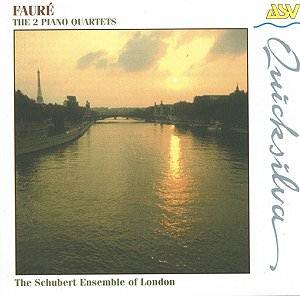
The First Quartet had previously found its way onto a BBC Music Magazine freebie but for the ridiculous price that these Quicksilva CDs retail at it is surely good to have the more mercurial and substantially beautiful second Quartet into the bargain. I would like to see more of the Schubert Ensemble of London on CD. Their playing is an utter joy especially in the expansive first movement marked Allegro molto moderato of the 1st Quartet. Simon Blendis' violin is charming and lightweight whilst the frivolous piano playing of William Howard adds a genuine spice to the proceedings. If the 1st quartet is slightly Mozartian and Haydnesque in feel then the 2nd is definitely reaching out into larger pastures. Here the maturity and discursive élan of Faure's music is distilled with almost whimsical beauty. One can imagine the thought that went into such nobly impassioned music. The Adagio is a particularly elevated piece where the intense lyricism is thoroughly inspirational in mood and content. ASV's recording is clear and Duncan Reid's lengthy notes put this disc at the top of the pile for bargain hunters and the seasoned collector with quality uncompromised. Indeed these versions are set to become standard for many years to come.
Reviewer
Gerald Fenech
Performance:

Sound:

JOHN FIELD Nocturnes 1 - 12; Rondo in E (Le Midi); Rondo in E flat (Sonata No 1) Alan Cuckston (piano)
Swinsty Records [DDD] FEW 115
Save around 22% with
the retailers listed alongside

What sensitive playing. How well Alan Cuckston brings out the romanticism in this music which is often played as anaemic, dreary, wishy-washy stuff. The opening Nocturne is beautifully captured as a melody with flowing accompaniment, and what melodic lines there are. The second nocturne is even more sensitive and, in this performance, has a rich beauty and the minor key makes it more telling. It is played with great feeling and security. In fact, the music's confidence is expertly realised. Some unexpected harmonies distinguish the third nocturne but it has predictable cliches. The A major nocturne is not easy to bring off and yet here it is so effortless and mercurial. While there is a delicacy in the playing it is certainly not feeble.
As you listen to the opening of the fifth nocturne what famous piece does it remind you of? And the opening of the sixth as well ... which is a very elegant piece. I do admire Alan Cuckston's straightforward playing and his exquisite cantabile style. The seventh, like number 4, also in A major, is very difficult to bring off; the melody line is so integrated with the accompaniment that it can easily be 'lost heard of'. There are some good harmonies and one repeated but extraordinary phrase leading to a cadence. The melodic line is highly decorated and florid. The eighth has a playful, child like quality with a hint of introspection (or nostalgia) and is rooted in E flat, probably Field's favourite key.
The E minor nocturne is a mature piece and once I heard a famous pianist play it without its ornaments and this was a revelation and, in my view, it worked.
Nocturne no 10 has a glorious theme and doesn't it remind you of a famous Beethoven piece? But this nocturne seem endless ... but it is beautifully played.
The problem with these nocturnes may be their lack of drama and contrast.
Curiously, nocturne no 11 begins with a theme similar to another famous work. It has the charm and elegance of Mendelssohn and is a very attractive piece. The final nocturne in this collection is in D minor and it has a few surprises and an extraordinary phrase as does number seven.
The Rondo: Le Midi is a delight and very infectious. One or two strange things happen on the way and watch out for the chiming clock.
The rondo from the Sonata No 1 is really a scherzo ... mischievous and 'naughty' in flavour. You'll have to hear it to see what I mean.
This disc should primarily be investigated for the music and its excellent execution but, on the way, you could enjoy being a detective and following the trail I have left for you.
Reviewer
David Wright
Performances

Recording

ARTHUR FOOTE (1853-1937) Piano Trio No. 1 in c minor (1884) DMITRI SHOSTAKOVICH Piano Trio No. 2 Serafino Trio
rec Palma de Mallorca - 17-21 December 1999 SERAFINO TRIO (no number) CD available from the artists. Distribution via www.mp3.com [60 mins]
Hear sound samples or order disc from http://www.mp3.com/serafinotrio
Save around 22% with
the retailers listed alongside
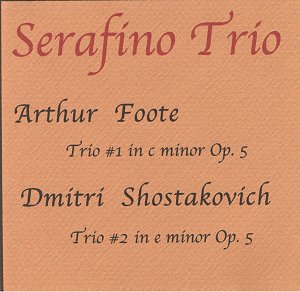
For what seems to be a first CD the Serafino Trio have not played safe in selecting repertoire. The Shostakovich is close to the mainstream but not 'safe'.As for the Foote, while the Second Trio was available on the North-eastern label during the 1990s this disc seems to represent the first trio's first recording on CD. Its idiom is a grown-up blend of Mendelssohn with a major infusion of Dvorák. The cello's role is richly taken by David Runnion but both Jennifer Peck (violin) and Suzanne Bradbury (piano) register strongly in this late classical era appassionata work. There is no hint of the run-through about this. Indeed I had the impression (possibly wrongly) that they had played this work in concert so well integrated does the performance appear to be. I specially noted the hell-for-leather dash of the Allegro vivace. Imagine if you will Dvorák's Cello Concerto, the Brahms Double Concerto and hints of the Mendelssohn Octet and you will get some idea of what to expect. The pliant and responsive tenderness of the adagio molto is also notable. A most enjoyable experience.
The Shostakovich is a familiar work: a twentieth century classic. Its spiritual opening takes us into Tavener and Pärt realms, while the second movement's convulsive brio takes us as close to delight as Shostakovich comes and the piano playing here is breathtaking. The funereal pace of the largo is Bachian but in a most imposing woebegone slow motion akin to the Preludes and Fugues. The turbid conflict of the finale find no punches pulled by the artist. The atmosphere mixes a Klezmer violin style with the extremes of emotional conflict. The artists do nothing to soften the conflict and yet the lyricism is there in full flood. A most impressive event.
Concert promoters would do well to hear this disc. If the trio have not yet appeared at London's Wigmore or Queen Elizabeth halls then they should be given the opportunity and for heaven's sake let them loose on the Foote and don't force them down the hum-drum route of 'safe' repertoire.
Perhaps there is some hope that David Runnion can get hold of the Arthur Foote Cello Concerto (1893) score and parts perhaps from the Free Library at Philadelphia. This, together with the Foote Cello Sonata (1910s) would make an ideal coupling. Foote's Francesca da Rimini and Four Character Pieces after Omar Khayyam both colourful vital orchestral scores from the 1890s are also well worth seeking out.
A most engaging disc and one with both promise for the future and immediate access to two vivid musical experiences. If there is a downside to the disc it is a slight sense of congested claustrophobia sensed during the most intense musical passages. Otherwise the recording seems to do fine justice to these artists. I hope they will now delve deeper into the rare trio repertoire.
Reviewer
Rob Barnett

The Serafino Trio are based in Spain and can be contacted for copies of this CD and for other information. The Trio can be contacted at c/Formentera, 8-1 07013, Palma de Mallorca, Baleares, SPAIN
Phone/fax (34) 971 793 714
dbr@cafeinternet.es
website: www.serafinotrio.com[The cover was scanned from a disc supplied by the trio - not the mp3 version. The Opus number is incorrect for the Shostakovich which should be Op. 67]
GOTTSCHALK: Piano Music for 2 and 4 hands. Alan Marks and Nerine Barrett.
Nimbus NI7045/6 107m DDD.
Save around 22% with
the retailers listed alongside
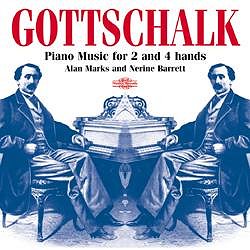
.
The music of Gottschalk is entertaining and can nonetheless be extremely rewarding as in this well selected collage of piano music for various hands combinations. Nimbus have sensibly split the discs with the two hands featuring on one and the four hands on the other. Of the latter (four hands), I was deeply enthused by the various picturesque impressions including a scintillating caprice and brilliant and heady impressionism in 'La Jota Aragonesa'. Alan Marks and Nerrine Barrett are perfectly in unison in the latter piece and they make many grand rhetorical flushes out of the delightful 'Orfa' and 'La Gallina', both singular representations of Gottschalk's pianistic prowess. My only quibble with this first disc was the short timing of just over three quarters of an hour but this is a 'two-for-one' offering and with such quality playing the skimpy timing was more than acceptable!
Alan Marks has the second disc to himself, which contains some very beautiful music. Some are obviously 'Americanized' pieces such as the 'Union' paraphrase but the Spanish connection is also deeply present. Marks plays the delightful 'Souvenirs d'Andalousie' with consummate skill. He is also a very persuasive advocate of the deeply felt meditation, 'The Dying Poet' and the host of other pieces that complete the disc, especially the trendy 'Tournament galop'. There is nothing overtly cerebral in this music but the melodies and fine craftsmanship are very endearing. Completists may wish to collect Hyperion's ongoing Gottschalk series superbly played by Marc Andre Hamelin but bargain hunters and other piano enthusiasts should be well served by this excellent Nimbus 'twofer'.
Reviewer
Gerald Fenech
Performance:
Sound:

REYNALDO HAHN (1875-1947) Piano Quintet (1921) [26 mins] String Quartet No. 1 (1939) [18 mins] String Quartet No. 2 (1940) [23 mins] Alexander Tharaud (piano) Quatuor Parisii
world premiere recordings AUVIDIS VALOIS V4848 [67.45]
Save around 22% with
the retailers listed alongside
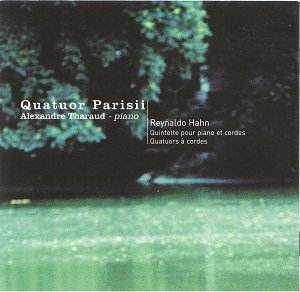
Hahn is better known for his operetta Ciboulette and for his songs than for the chamber or orchestral music. In fact there is a violin concerto, a piano concerto as well as a substantial quantity of chamber works.
Once again Auvidis Valois have produced a matchless product - exemplary performances, recording and documentation in French and English. The photographs are especially good.
The music is determinedly melodic in character - so no surprise there! The style leans towards Fauré and Franck rather than towards the perfumed gardens of Schmitt, Ravel and Debussy.
The quintet which was the most frequently performed chamber work during his lifetime is torrentially tuneful. It bursts the bounds of joyous celebration in music of succulent ecstasy in a way closer to Franck and Chausson (as in the Concert) than to the involved subtlety of late Fauré. This is true of the two flanking movements of the three movement work. The central movement is more reflective. You simply have to hear this piece if you have any affection at all for the chamber works of Fauré or Franck or Chausson.
During the 1910s and 1920s Hahn denied the attractions of the string quartet. It was only on the brink of (or over the edge of) another War that he recanted and produced in quick succession two essays in the medium. At his death he was intending to start a third.
The first quartet is harmonically involved but after an introit it moves into an almost Viennese theme - dashing and carefree with a Dvorákian character and a hiccup in the line. Some of the momentum is lost towards the thoughtful end of the first movement. The low key medieval carol of the second movement contrasts with the severity and reserved trudging sweetness of the andantino. A Mozartian lightness of spirit breathes through the flighty allegro assai - utterly delightful. This is a wonderful discovery. The second quartet also has four movements imbued with Mozartian levity and unaffected sentiment, Bachian firefly grace, a devil-may-care panache, thoughtful awed reflection (in the Posément) and a Très Vite that has the breezy step and mercurial manner of a man-about-town.
Once again thanks are due to L'Association Française pour le Patrimoine Musical for funding this fine revival. Can we expect more Hahn? How about now turning to Guy-Ropartz's Symphonies 1, 2, 4 and 5?
Recommended to Gallophiles, to anyone at all interested in the development of chamber music in France and to any listener intent on broadening their repertoire of tuneful fibrously substantial chamber music … in fact to anyone who wants to their stock of genuinely emotional and accessible chamber music.
Reviewer
Rob Barnett

HALVORSEN: Stage Music Vol 1. 'Gurre': Dramatic Suite for Orchestra Op. 17, Askeladden, Suite, The Merchant of Venice - Suite. Latvian National Orchestra Terje Mikkelsen
Simax Classics PSC1198
Save around 22% with
the retailers listed alongside
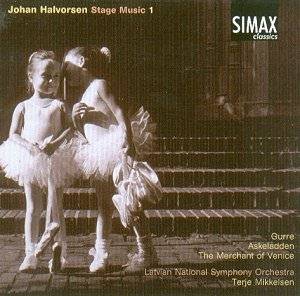
A lovely disc indeed! Halvorsen's beautifully crafted stage music is rather reminiscent of Sibelius but still retains an authentic charm that is characteristically personal. This composer dominated Norwegian music for many years and understood the drama scene perfectly due to his conducting the Royal Norwegian Theatre for over thirty years. The three works recorded here are full of immense charm and there are some beautiful melodies that remain in your head long after the first hearing. The epic 'Gurre' had already been treated by Halvorsen's Danish counterpart, Hornemann (available on Chandos) but the Norwegian's undramatic score is delicate, rather frescoe-like; at times Rimsky Korsakov is not too far away. The opening evening scene is played with deep feeling by the Latvian Orchestra who also command a remarkably succinct string tone. The same goes for the concluding 'Woe King Volmar', an epic march rather in the mould of Grieg's 'Homage March'. 'Aladdin' has also been set by a Danish composer (Carl Nielsen) and Halvorsen's setting is delicate and imaginative although it lacks the punch of the much more famous Nielsen version. I was charmed by 'The Merchant of Venice' which includes some delightful short movements in the shape of 'Portia' and an aptly titled 'Intermezzo'. Terje Mikkelsen conducts with feeling and passion for these romantic scores and Simax's recording is clear and truthful. On the whole, the project is commendable to anyone looking to enhance his orchestral CD collection.
Reviewer
Gerald Fenech
Performance:
Sound:

George Frederick HANDEL Handel at the Opera overtures, arias and ballet music Collegium Musicum 90 conducted by Simon Standage
Chandos Chaconne CHAN 06550 [66:37]
Save around 22% with
the retailers listed alongside
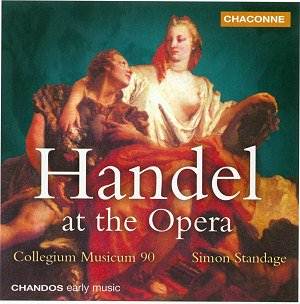
.
This is an unusual opera anthology, in that although it contains five arias there is no whisper of the human voice. In total the disc features music from seven of Handel's operas, offering besides the arias an equal number of overtures, the remainder being comprised of ballet selections. It may be unusual, but given the frequency with which we are offered collections of vocal excerpts, why not an instrumental programme?
Handel at the Opera opens with 21 minutes of music from Alicina HWV34, by far the most fully represented work. Handel completed Alicina on the 8th of April 1735, by which time he had been writing opera for the London stage for a quarter of a century. The first performance was given at Covent Garden just 8 days later, and to where Handel had recently relocated following the loss to his company of the King's Theatre. Covent Garden may have been less prestigious and smaller, but it did offer one distinct advantage, a troupe of French ballet dancers in the employ John Rich, the theatre manager. Therefore, as he had occasionally in the past, Handel began to incorporate dance sequences into his operas. Thus, apart from the overture, we are given eight brief dances pieces from Alicina, and one aria.
Such was the thirst for Handel's music that instrumental arrangements were made by various musicians for performance both public and private. Finally the inevitable happened, the arrangements became so successful that they made their way back into the opera-house, where they were used as interlude music between scenes. It is of course performances of these arrangements which appear on this instrumental collection.
Armino HWV36 dates from the following year and is here represented by the overture and a brief minuet, while Serse HWV40, composed in the winter of 1737-8, inevitably provides, by 'Ombra mai fu', originally an aria for the castrato Caffarelli, now forever immortalised as 'Handel's Largo'. There is an aria from Handel's, first London opera, Rinaldo HWV7 and rather more extended sequences of music from BerniceHWV38, Rodelinda HWV19 and Ariodante HWV33.
Simon Standage, a founder member of the English Concert and Professor of Baroque Violin at both the Royal Academy of Music and the Dresdner Akademie fur Alte Musik, and Collegium Musicum 90 are together on familiar ground, having already recorded three volumes of the Handel Concerti Grossi for Chandos, together with Apollo e Dafne and Crudel tiranno Amor. Performing with calm confidence on authentic instruments or modern replicas they achieve a very natural and well-balanced sound. The music is of course rather more relaxed than Handel's famous instrumental show-pieces, the Water and Fireworks music, yet holds much that should captivate both the general listener and the devotee of the composer's music - I am always loath to use the term Handelian, the implicit idol worship doing neither party justice. Likewise, if the Concerti Grossi appeal, so should the music here.
On caveat: Handel at the Opera is perhaps a disc to be played in small doses rather than taken all at once. This music was meant to be part of a greater event, and it may offer its best rewards as one element in of an evening's listening. Beguiling and pleasurable, most definitely yes, a treat to have in the collection when something a little different is in order, yet probably not an album to play all the way through and lend one's fullest attention. Nevertheless, a most warmly recommended release.
Reviewer
Gary S. Dalkin

HAYDN String Quartets Op76, no1 in G; No2 in D minor (Fifths); no3 in C (Emperor) The Lindsays
ASV CD DCA 1076 [DDD] [74' 39"]
Save around 22% with
the retailers listed alongside
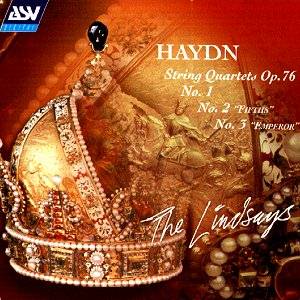
Simply wonderful.
These are marvellous, superlative performances of most endearing and endurable music. Haydn's quartets when played like this have no equal. There is such an elegance and polish in the Lindsays' playing as well as a remarkable logic and coherence so that the musical form and structure is clear and beautifully set out.
The slow movement of the G Major is very telling and often quite moving. And I do admire the Lindsays' choice of tempo which is always well judged. No music drags and the allegro movements are just that. There is never any excess, self-indulgence, effeminacy at cadences which ridicules baroque music; in fact, no quirky mannerisms. Even the slightly eccentric presto minuet in the G Major is played 'straight' and therefore makes its point precisely. The finale has some splendid interplay.
And the recorded sound could hardly be better.
The magnificent D minor prefigures the romantic style of composition easing away from the classical and quasi-baroque. From the very opening we know that the Lindsays are going to bring out the passion of this glorious movement. And they do. The counterpoint is realised impeccably and the high spirits of the finale are expertly caught.
The Emperor is not a favourite of mine, but it is also played very well indeed. It is something of an introspective work often described as ceremonial music which genre does not suit the string quartet.
Nonetheless this disc is heartily recommended. I cannot imagine better performances.
Reviewer
David Wright
Performances

Recording

HENZE Works for Two Guitars. "Minette: Canti e rimpianti amorosi" per 2 chitarre; Memorias de "El Cimarrón" for two guitarists (1995) and Drei Märchenbilder aus der Oper "Pollicino" (1980) Jürgen Ruck and Elena Càsoli (guitars)
MDG Gold. MDG 304 0881-2. (59' 56'')
Save around 22% with
the retailers listed alongside
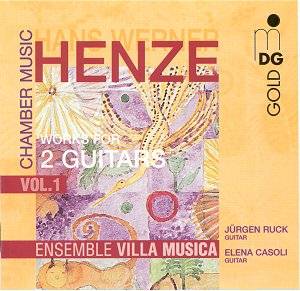
This disc is headed "Henze: Chamber Music Vol.1" which is an encouraging prospect as little of this great contemporary composer's chamber works are available on CD. Henze is one of the most interesting of today's artists whose writing, though unquestionably of our time, is rooted in the musical traditions which so many other recent composers have seen fit to ignore. It is this juxtaposition between the familiar and the unfamiliar which makes Henze's works so enjoyable as well as challenging. This juxtaposition is well demonstrated on this CD. The disc begins with "Minette", a realisation for two guitars of an earlier opera called "The English Cat" to words by Edward Dent. The story of the opera is retained by the use of five arias and two duets from the opera to make up the seven movements. The writing captures the pathos of the story and the cat-like wailing (particularly in the last movement) is both recognisably feline as well as moving. Though Henze does employ twelve-tone rows in his writing, there are enough genuine melodies here to satisfy the most ardent anti-modernist and I found the piece to be most enjoyable and emotionally involving (the excellent notes in the accompanying booklet set out Minette's tragic story).
Memorias de "El Cimarrón" is a rather tougher nut to crack, employing as it does vocal effects (humming, whistling and tongue-clicking) as well as the use of the guitars as percussion instruments. The very start of the work is disconcerting to those expecting a more straightforward piece for guitars. However, the work has tremendous atmosphere, humour (in the form of acidic parody in "Das Herrenhaus" and "Die Pfarrer") and melodic and rhythmic invention (particularly in the delightful movement "Die Frauen" which emulates Cuban dance music). Repeated hearings help to overcome any initial misgivings over the extraneous noises which soon reveal themselves to be essential to the mood and indeed the essence of the work. It is a tribute to the fine musicianship of the two guitarists that these vocal and percussive aspects of the piece never sound eccentric or precious but rather make a vital contribution to the overall effectiveness of the work.
The CD finishes with the most charming and simple music on the programme: the Drei Märchenbilder from the opera "Pollicino". The original opera was conceived for children and thus the composer employs even more genuine tunes than usual, creating a delightful set of three small pieces which sound of the 20th Century and yet hark back to earlier, less complicated times. They are instantly memorable and should perhaps have started the disc to give the listener unfamiliar with Henze's soundworld a more appropriate entry into it. For those unsure if this disc is for them, I would recommend starting with the exquisite "Drei Märchenbilder" and then proceeding to "Minette" before plunging into the deep end with the "El Cimarrón" pieces.
It is no coincidence that all three works on this CD were inspired by operas as a melodic and cantabile quality informs all the best of Henze's music. For listeners who respond to the music in this CD, I would recommend getting to know the nine symphonies, the operas and the ballet music of this most exciting of contemporary composers. His erudite and humane biography "Bohemian Fifths" (published by Faber) also makes for fascinating reading. For those listeners getting aural indigestion on the excesses of the never-ending stream of releases of late-Romantic orchestral colossi, this gem of jewelled miniatures could prove to be the perfect palette-refreshing antidote. The recording quality on all three pieces is ideal, the players captured in the most natural of acoustics. The two guitarists Jürgen Ruck and Elena Càsoli display exemplary musicianship and a love and understanding of the works they are playing which would be the envy of any composer. I look forward with keen anticipation to further releases in the Henze Chamber Music series on MDG.
Reviewer
Paul Conway

HERBERT HOWELLS Hymnus Paradisi; A Kent Yeoman's Wooing Song (premiere recording) Joan Rodgers, soprano - Anthony Rolfe Johnson, tenor - Alan Opie, baritone - BBC Symphony Orchestra and Chorus - Richard Hickox
CHANDOS CHAN 9744 [65]
Save around 22% with
the retailers listed alongside
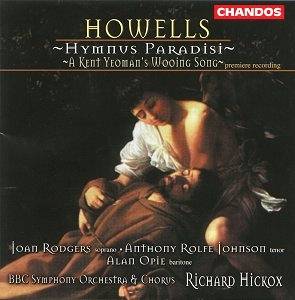
Believe it or not : this is the fourth recording of Howells' masterpiece. After Willcocks' historical reading (on EMI, now reissued in CD format), Handley's (on HYPERION ) and a more confidential one on JADE (JACD 032) which I do not know, here is Hickox's view of a piece which he had to record one day or another. This is the kind of work which he relishes and his performance may be one of the finest, if not the best of all, even if Handley's is almost as fine. Hickox's reading is marginally slower than Handley's but it has all the fire and precise articulation required. Il also receives a magnificent recording. Rarely have I heard the organ's pedal points with such immediacy. Just listen to the beginning of the last section to hear what I mean. The singing is superbly assured throughout : the soloists are excellent and the BBC Symphony Chorus copes bravely with Howells' demanding choral writing. Hymnus Paradisi is a great choral work and Howells' masterpiece. With four commercial recordings available it may be said to have achieved some sort of classic status its many qualities deserve. However as I mentioned in an earlier review Hymnus Paradisi will never be popular in the widest meaning of the word for the musical demands put on the performers will always lie beyond the capacities of good amateur choirs and orchestras. The same is true as far as Howells ' Stabat Mater and Missa Sabrinensis are concerned. We must therefore be grateful to CHANDOS for making all three works available for long, one hopes, in such fine performances and recordings.
The present release is also most welcome and a "must" for all admirers of Howells for the first recording of A Kent Yeoman's Wooing Song. This rather unusual work (i.e. by Howells' standards) written as a wedding present for Keith Falkner and his bride Isabel has Howells in an unusual extrovert mood. Though composed in 1933 it remained unscored and unperformed for nearly thirty years. It is possible the success of Hymnus Paradisi in the early fifties encouraged Howells to orchestrate the piece and have it performed. It is scored for soprano and baritone, chorus and a fairly large orchestra. The mood is extrovert and brilliant throughout and the piece as a whole is hugely enjoyable though again Howells' choral writing is as demanding as ever requiring much stamina, precise articulation and intonation, strength and resistance, which it gets in abundance in the present reading. This wonderful piece is new to me as it may be to many members and the present recording is thus a most welcome addition to Howells' expanding discography.
Hickox's performance of Hymnus Paradisi and Handley's are both very fine and the only way to avoid a painful choice is to have both recordings since each of them also offers a Howells premiere, i.e. An English Mass (Handley) and A Kent Yeoman's Wooing Song (Hickox). This most welcome release is unreservedly recommended.
Reviewer
Hubert Culot

Janácek: The Cunning Little Vixen cast below Kühn Children's Choir, Czech Philharmonic Chorus and Orchestra Václav Neumann
Supraphon 10 3471-2 (2 disc set)
Save around 22% with
the retailers listed alongside
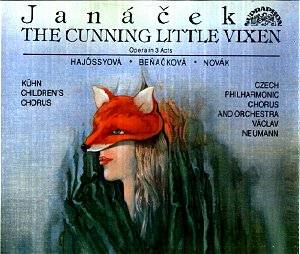
Magdaléna Hajóssyová (soprano) Vixen
Gabriela Benacková (mezzo soprano) Fox
Richard Novák (bass) Forester
Helena Buldrová (soprano) His wife
Miroslav Frydlewicz (tenor) Schoolmaster
Karel Prusa (bass) ParsonKühn Children's Choir, Czech Philharmonic Chorus and Orchestra Václav Neumann
Janácek's instinct and sympathy for rural life comes most clearly into focus with The Cunning Little Vixen (Brno, 1924), in which he transformed a newspaper cartoon strip into an affirmation of the cycle of life. Of course the rustic characters and the various animals and birds, who together comprise the cast list, afford splendid opportunities for designers. But the music is inspired too, in particular the glorious sunrise sequence and the moving conclusion in which the young vixen appears and succeeds her dead mother, thus confirming the renewal of life.
Along with Jenufå, this is probably the most widely known of Janácek's operas, and it has been well served by four recordings. Bohumil Gregor's account with the forces of the Prague National Theatre, well recorded by Supraphon in 1970, has all the freshness and vitality of a live performance, while the famous Charles Mackerras-Vienna Philharmonic version on Decca (1981) has been firmly established in the catalogue ever since its release. Of equal interest is the version conducted by Simon Rattle for EMI (1992) with the forces of the Royal Opera House, Covent Garden, and sung in English.
Václav Neumann's recording with the Czech Philharmonic and an all-Czech cast dates from 1979, during his extended tenure as chief conductor. He is better known for his recorded legacy as a conductor of the concert repertory, but the keen sense of ensemble achieved here by the idiomatic Czech forces owes much to his direction. The recording is nicely balanced if without quite the sheer impact of the EMI and Decca versions, but there are compensations in abundance, largely because the Czech singers bring such sensitivity to the text, working very much as a team.
One of Janácek's greatest achievements in this opera is the fusion of dramatic pacing with atmospheric musical invention, and in the latter sense especially the Czech Philharmonic Orchestra can be heard at the top of its form. Sometimes, in fact, the orchestra takes 'centre stage', rather than the singers. Therefore the performance is at its most successful during those scenes such as the sunrise, when the music naturally explores this priority.
With a total playing time of less than 100 minutes, this two-disc set is less imaginatively compiled than its EMI and Decca rivals, which offer extra orchestral items. But the accompanying booklet is one of the best Supraphon have compiled, including an introductory essay, a scene-by-scene summary and a well organised libretto with full translations. There is much to commend this issue.
Reviewer
Terry Barfoot

ALEMDAR KARAMANOV (b.1934) Symphony No. 3 (1956-64) Piano Concerto No. 3 Ave Maria (1968) Vladimir Viardo (piano) Moscow SO/Antonio de Almeida
rec 3 Nov 1994, Moscow Conservatory, Grand Hall MARCO POLO 8.223796 [73.38]
Save around 22% with
the retailers listed alongside
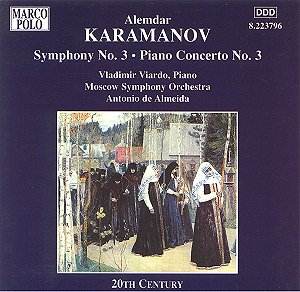
Alemdar Karamanov (born in Simferopol) is a Crimean composer (he wrote the Crimean national anthem) whose prolific symphonism has produced more than 24 symphonies. Information about him is rather short on the ground but Ates Orga's notes to this release are especially helpful. I rather wish we heard more from Mr Orga.
Karamanov was a friend of Schnittke who studied with both Khrennikov and Kabalevsky. His first works were perhaps trendily avant-garde. His Third Piano Concerto Ave Maria was heard in London in 1997. Karamanov's meditative quasi-religious music is as attractive (and instantly so) as Giya Kancheli's symphonies or Valentin Silvestrov's Fifth Symphony. This family of composers can be counted in the same company as Gorecki's Symphony of Sorrowful Songs and Arvo Pärt's Cantus. There is no reason why this music, in its long and frankly melodic lines, should not enjoy the same success.
The Third Symphony is an early example beside the Decca and Olympia issues however despite the above notes it is not a forbidding work having more in common with Khachaturyan and Prokofiev (Romeo and Juliet) than with the thorny splendours of Shchedrin and Denisov. The first movement is full of beautiful touches including a deliriously insistent trumpet solo over trembling strings. Its dervish of a storm quickly dissipates resolving into an uncertain serenade of Miaskovskian mien. The moderato (II) features a chaos of birdsong and music that could easily be placed close to Prokofiev's Scythian Suite. The ensuing Andantino's sadly chiming vibraphone speaks of an accessible humanity and does so without sourness or the taste of cordite. The finale is an allegro of Tippett-like élan - rather cold emotionally.
The piano concerto is somewhat Rachmaninovian (but with less incident), with touches of Scriabin (the tune-smith as in the piano concerto rather than the later 'godlike delusion' works) and the main Andantino theme uses a melody of some nagging persistence which sounds like Vaughan Williams. It is here especially that I thought of Silvestrov and Gorecki. Altogether a rather striking work which achieves reverence without religiosity.
Although I recall the other two Karamanov discs listed below as having been reviewed in Gramophone the present Marco Polo does not seem to have made that particular 'grade'.
Reviewer
Rob Barnett

A KARAMANOV DISCOGRAPHY
KARAMANOV
Symphony No. 20 "Blessed are the dead"
Symphony No. 23, "I am Jesus"
USSR SO/Vladimir Fedoseyev.
OLYMPIA EXPLORER SERIES OCD486
KARAMANOV
Symphony No. 22 "Let it be"
Symphony No. 23, "I am Jesus"
Deutsches SO, Berlin/Vladimir Ashkenazy.
DECCA 452 850-2DH
Enquiries to
Kasevin Rodell
Karamanov Society
6 Bowling Green Road
Cranfield
BEDFORDSHIRE MK43 0ET
United Kingdom
(fax 01234 751881)
Erich Wolfgang KORNGOLD Juarez - The Private Lives of Elizabeth and Essex - The Sea Wolf James Sedares conducting the New Zealand Symphony Orchestra
Koch International Classics 3-7302-2H1 [60:35]
Save around 22% with
the retailers listed alongside
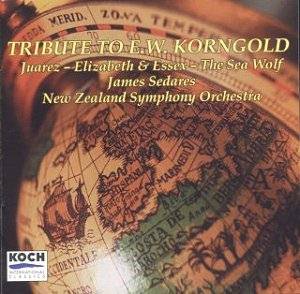
.
There is no mistaking his master's voice. With Max Steiner, Erich Wolfgang Korngold all but invented the sound of Hollywood film music, and his influence persists today whenever a symphony orchestra is assembled to perform the music of John Williams, Jerry Goldsmith, James Horner and countless others. All the more remarkable then, that Korngold considered himself primarily a concert composer, and only wrote a total of 19 film scores. Consequently, more than most, Korngold's film writing forms a continuum with his 'serious' work, his writing for whatever venue always thoroughly through-composed, his film work usually able to stand alone away from the silver screen.
Three films are featured. The album opens with a 27-minute suite, Pided into 16 parts, from Juarez (1939). This is fiery and exciting music, full of action and swashbuckling adventure, and with characteristically fine main and love themes. The Spanish flavour is not as strong as might be expected, for essentially Korngold wrote Korngold, no matter the subject. One oddity is that, although the disc is lavishly packaged, with stills and extensive booklet notes, including full documentation of the orchestral players, there is no credit for the soprano voice which appears on the interpolation of the song 'La Paloma' into track 8: 'Farewell'. Further, although the notes on Korngold and Tony Thomas are informative, the memoir on the latter appears with no explanation of any direct connection between the man and the CD. Presumably Thomas arranged the suites recorded here.
Next is a comparatively short suite from The Private Lives of Elizabeth and Essex (1939), and if one wanted to be really pernickety, it could be argued that in these days of 75 minute plus albums, we could have been offered a little more than 6 minutes. This suite, offering the opening and closing music, a fanfare and march, is very much in the mould of The Sea Hawk, and is a delight while it lasts. However, given that many Korngold aficionados will already have a recording of the complete score, of rather more interest is a 27-minute suite from The Sea Wolf (1941). Yet again we are given maritime adventure, but this time of a darker hue for this wartime tale of desperate peril. Suffice to say, it is hard to imagine anyone with a love of Korngold's film work being disappointed by this suite, while it has many qualities which may appeal to those who find his music sometimes overblown or sentimental. If you thought the composer specialised only in rousing heroics and sweeping romantic melodies you may be surprised to find the almost Herrmannesque atmospherics of 'The Fog' and 'The Shipwreck', while even the 'Love Scene's is far more lyrically understated and pastoral than comparable themes from Devotion or King's Row.
The criticism that has sometimes been levelled against James Sedares and the New Zealand Symphony Orchestra, particularly for their superb disc of Miklos Rozsas El Cid, is here utterly confounded. This is simply a magnificent recreation representation of Korngold's music, presented not on thin 'authentic' distorted mono sound, but as the composer can only ever have dreamed of, with rich and dynamic stereo sound, with utterly committed and finely accomplished performances. There are still too few recordings of 'Golden Age' film music, and a recording of this calibre is to be warmly welcomed by anyone seriously interested in cinema as a musical art form.
Reviewer
Gary S. Dalkin

BENJAMIN LEES Symphony no 4 'Memorial Candles' Kimball Wheeler (soprano), James Buswell (violin), National Symphony of Ukraine, conducted by Theodore Kuohar
American Classics Naxos. 8.559002
Save around 22% with
the retailers listed alongside
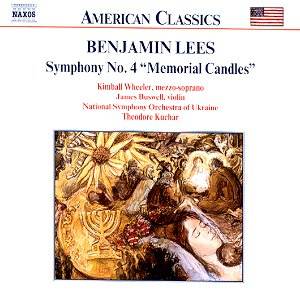
Well done, Naxos!
Benjamin Lees is an American composer who was born in 1924. He is a composer who has deservedly won many prizes and awards and I have particularly enjoyed his orchestral works over many years.
As the title suggests the Symphony no 4 is dedicated to the victims of the holocaust and the soprano sings some verses written by a survivor.
The symphony does not have the dramatic power of say Schoenberg's masterly A Survivor From Warsaw and I am sure that Lees intended that to be so. What we have is a compelling work at times that needs to be listened to and not just played. It is aurally accessible and so those who are savage about modern music can relax.
Naxos have provided the text of the verses in the excellent booklet and their effective message is enhanced by the music. The first setting has a title which is fascinating in itself ... .Someone Blew The Shofar. The horror and gall of the next song But Who Emptied Your Shoes Of Sand? is very evocative and what is captured in the last song Footsteps is most telling, for those who have the appropriate insight
Worth investigating.
Reviewer
David Wright
Performance

Recording

See also earlier review by Rob Barnett as part of a survey of the Naxos American Classics
LOCATELLI Concerti Grossi Op 1 nos 1-6 Capella Istropolitana Jaroslav Krecek.
Naxos 8.553445 [DDD] [50' 27]
Save around 22% with
the retailers listed alongside
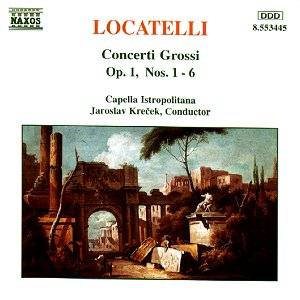
Pietro Antonio Locatelli was born in Bergamo on 3 September 1695 and died in Amsterdam on 30 March 1764. He was the greatest violinist of his time.
He published ten works, or collections, and his opus 1 published in Amsterdam in 1721 consists of twelve concerti grossi of which this disc includes the first six. Each contain a Fugue.
He is a figure shrouded in a mystery which has wasted the time and energy of musicologists. Did he ever study with Corelli? Locatelli was probably the first composer to value the 'Cinderella' of the orchestra, the viola. He wrote principally for strings with the exception of the Flute Sonatas Op 2 published in 1732.
He led an interesting life as a virtuoso and had wide interests. He was not a typical Italian baroque snob since he dedicated a lot of his time to amateur musicians as did Vivaldi with the girls' school he supported. He was a businessman specialising in instruments and their accessories. As with Paganini a century later, his violin playing did not please everyone since it was considered too phenominal to be human. There are fascinating stories, which may be apochryphal, such as the song bird who died because he could not compete with the beauty of Locatelli's ravishing playing.
Sadly, these performances lack energy and 'bounce'.
They are workmanlike enough but the sparkle is seldom there. This is such a pity for it gives the impression that Locatelli was only an average composer.
This aside, for £4.99, you may consider it a bargain.
I remember the happy days when we used to perform these concerti with great verve and so I was disappointed with this disc.
I wonder what this group would do with the more striking Locatelli scores such as the Concerto Grosso in EFlat Op 4 No 6 known as Ariadne's Lament
Reviewer
David Wright
Performances

Recordings

BENJAMIN POCHI MA (1964-) The Music of Benjamin Pochi Ma Vol. 1 Symphony in g minor Requiem Ohne Worte and 11 chamber works various soloists, Shanghai Philharmonia Orchestra conducted by Li Jian Ping
OMNIS ARS 020-99-672-01 c. 58 mins
Save around 22% with
the retailers listed alongside

This production showcases the music of a young composer with no hang-ups about communicating to his audience. Pochin sees no need for 'filters', 'prisms' or 'distorting mirrors'. Instead he seems utterly in equilibrium writing music which is far from original in expressive language but fresh in tuneful ideas. Ma is not at all obtuse about his influences and they are laid disarmingly in front of us.
In many ways a composer writing music in this way offers up his creations with totally disarming candour. There is no attempt to hide ideas behind a weave of innovation and avant-garderie. Instead the ideas are presented in styles already well known to most listeners. That language is freely Romantic and sometimes popular particularly approachable if you enjoy Richard Clayderman or Semprini classics although this music is original rather than an arrangement.
The Destiny Sonata is unassertively Gallic (Saint-Saens) with a glancing blow or two from Scott Joplin's ragtime and a splash of Beethovenian rage over a lost penny. There is a dreamily glum Septuple in Melancholy for solo violin, a Schubertian Fantasia for string trio, a restfully rocking Song Without Words for piano and small chamber ensemble and a jolly Pastorale for solo piano. Ali in Liberta has a touch of Nyman about it. Bach and Schubert stalk the pages of Conzia Carissima (for piano, two clarinets and two cellos). There is an energetic Tarantella set off rather nicely by the undemandingly soothing Canon For Cecily (string trio). The Tempest Prelude and Fugue in e minor is decidedly unacademic.
The 12 tracks (a work to each track) are brief and the more cynical listener may well say that this is music written for the reduced attention spans of the MTV generation and (in the UK) the ClassicFM generations that thrive on a movement from this and prelude from that.
The tracks are, in all but one case, for chamber forces and the longest runs only 7:12. This single orchestral track is a one-movement symphony not helped by decidedly bush-league (intonation suspect and creaky playing generally) orchestral playing by the Shanghai Philharmonia Orchestra conducted by Li Jian Ping. However you can see what Ma is getting at; stepping off where Beethoven's Eroica and Schubert's Unfinished end. The chamber tracks are much better done and the recording is fine. The notes by the composer are practical and helpful. Not specially compelling but sincere and promising - qualities to be cherished even if the music perhaps falls short of the high ambitions that conceived it. I would be very pelased to hear later volumes in this series. Ma's is a name to watch.
Reviewer
Rob Barnett

Available from OMNIS ARS Ltd
25e Superluck Industrial Estate Phase 2
57 Sha Tsui Road
TSUEN WAN
HONG KONG
tel 852 2412 1239
fax 852 2412 3848
e-mail omnis@omnis-ars.com.hk
http://www.omnis-ars.com.hk
MAHLER: Das Lied Von Der Erde John Mitchinson (Tenor), Alfreda Hodgson (Mezzo) BBC Northern Symphony Orchestra Conducted by Jascha Horenstein BBC Legends BBCL 4042-2 apprx £12
John Mitchinson (Tenor), Janet Baker BBC Northern Symphony Orchestra Conducted by Raymond Leppard The BBC Classic Collection BBCM 5012-2 bargain price approx £5
Save around 22% with
the retailers listed alongside
Here at last is the official issue of Jascha Horenstein's BBC studio recording of Mahler's late masterpiece, made under ideal conditions a year before his death. The BBC Northern Symphony had never played the work before so Horenstein was given time to rehearse them thoroughly. The result is an expansive performance that repays repeated listening because the degree of space he gives the music, allied to the familiar fingerprint of modular tempi to suit entire movements, takes us deeper than ever.
Horenstein's view of this work is dark and tinged with tragedy. Through this first song the tread is heavier, the weight of the world greater, the mood reflective. To some this might take a little getting used to, but persistence brings rewards, not least in the change of mood with the third stanza "Das firmament blaut ewig" ("The heavens are ever blue") and the opportunity Horenstein takes to mark the pizzicati in the passage while the singer is silent. Evidence of his care for inner detail allied to outer structure. After such a performance of the first song the second comes across colder than usual, closer to despair. The phrasing of the oboe is exemplary in its lamenting quality as Horenstein continues his deep analysis. Then Alfreda Hodgson's first entry is unobtrusive, her voice darker, more earthy. There is some surge of feeling at "Bald werden die verwelkten goldnen Blatter" but no real warmth, so I think Horenstein wants to stress the utter loneliness in the poem.
In "Von der Jugend" Mitchinson lightens his approach but Horenstein's held-back accompaniment reveals more angst beneath the surface. In the fourth song Hodgson's opening is as good an example as any of her feeling for words and Horenstein gives her just the space she needs. You are also aware that this song has three parts and I like the half-tone Hodgson adopts at the end where Horenstein closes the movement as you would expect, a real awareness of winding down. He is also wonderful at the chamber-like textures, helped by the closer-in recording.
The opening of "Der Abschied" is doom-laden, promising a heavy journey. Hodgson enters almost with fear, as if she is going to cause the world to end if she sings loudly. The passage describing the birds shows a conductor steeped in the Viennese tradition of that time and what conducting and playing there is around "Es wehet kuhl im Schatten meiner fichten", the words almost whispered by Hodgson and the feeling of rapt expectation extraordinary. This remarkable performance was done in one take, as if it was in front of a live audience, and I don't think I have ever heard passages where Mahler pares everything down to a few instruments taken so slowly and with such concentration.
It's hard to find words adequate to describe the final pages. Taken at as slow a tempo as could be dared, soloist, conductor and orchestra sustain a line that is unutterably moving. Indeed, there are passages in this last song where time almost stands still. According to John Mitchinson, most of the orchestra were in tears at the close.
The remastered sound from the BBC master tape is analytical, tailored for broadcast, accentuating Horenstein's way with the chamber textures where every detail is exposed by his gimlet eye. The orchestra play well but don't have the corporate elan of one of the international ensembles. However, surface sheen is not everything and I cannot recommend this recording too highly. Here is a performance where both the soloists balance each other and are matched with a conductor whose contribution is one of the greatest ever. Admirers of Horenstein will also be fascinated to hear a brief interview with him in which he speaks of his relationship to the piece and also to read the splendid notes by Joel Lazar, Horenstein's assistant at the time, who has much to tell us about the working methods of this remarkable conductor.
Five years after the Horenstein studio recording the BBC Northern Symphony performed the work "live" at the Free Trade Hall in Manchester with Mitchinson again the tenor, but this time with Janet Baker as his partner and Raymond Leppard conducting. We can speculate on how much Horenstein's influence was still with these players but it would be nice to think many carried the experience of working with him that night.
Leppard presses forward in the first song and I like the cackling woodwind against the opening horn figure each time it re-appears. For his part Mitchinson is encouraged to be more dynamic and energetic this time. It may be the presence of an audience that makes him project more but the "ape on the graves" section receives more hysteria than it did with Horenstein. He and Leppard are very perky in "Von der Jugend" with a lightening of tone after what has preceded. Mitchinson is certainly freer to smile more than he did under the rather glum Horenstein because Leppard is a more approachable character with less early-century Viennese angst. Again in the fifth song Mitchinson and Leppard go for energy. I found the delivery of the passage starting at "Ein Vogel singt im baum" contained a real Wunderhorn quality reminiscent of the Third Symphony's second and third movements.
When Janet Baker makes her first appearance in the second song we are in the presence of one of the greatest of all Mahler singers and her interpretation is formed from the first word with a tone so full it has the effect of shifting the entire attitude of this movement to something more than just a description of loneliness to the act of being lonely. Listen in "ein kalter wind beugt ihre Stengel nieder" ("an icy wind blows down their stems") how she halves her tone for the last words and likewise, after the outpouring at "Sonne der Liebe willst du nie mehr scheinen" how she tempers this in the same way at "mild aufzutrocken" ("my bitter tears") with almost a whisper. Few singers can describe the young girls playing by the river in "Von der Schoenheit" like Baker either. An openness of heart is the best description and notice the pause on the word "Neckerein" ("teasingly").
Sheer weight of tone is rather missing from the tolling at the start of "Der Abschied". It could have done with a little extra funeral tread for Leppard is less good on tragic weight in this work. But when Baker enters reservations must be put aside. There is an immense contrast between the last time we heard her and now, and this ability to cover a whole world of meaning is one of the many reasons why she is so great in this work. The recording balance favours the winds and they play with character, if not with the cultured tone you would expect from one of the great Mahler ensembles. But that was true also of their account for Horenstein. "Er stieg vom Pferd und reichte ihm den Trunk" ("He dismounted and gave me the parting cup") is a token for what is to come since Baker's account of the final part of this work surpasses everything she does and that was formidable enough.
If forced to choose between these two BBC issues I would opt for Horenstein. But Janet Baker is too good to miss. So, for the small extra price of the bargain Leppard recording, why not have both versions of this timeless masterpiece?
Reviewer
Tony Duggan
Horenstein

Leppard

Martinu: Julietta cast below Chorus and Orchestra of the National Theatre, Prague cond. Jaroslav Krombholc
Supraphon 10 8176-2 (3 disc set)
Save around 22% with
the retailers listed alongside
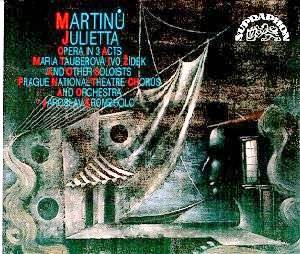
Maria Tauberová (soprano) Julietta
Ivo Zidek (tenor) Michel
Antonín Zlesák (baritone) Inspector
Véra Soukupová (mezzo soprano) Fortune tellerChorus and Orchestra of the National Theatre, Prague cond. Jaroslav Krombholc
Martinu was one of the most prolific composers of the 20th century, working in all the main genres, including opera. He wrote fourteen operas in all, and they are well worth exploring. While The Greek Passion is more frequently performed outside the Czech Republic, it is Julietta (1938) that can lay the strongest claim to being Martinu's operatic masterpiece.
Martinu spent the majority of his career working away from his homeland. From the early 1920s he was based in Paris for nearly 20 years; then following the outbreak of war he fled to America, black-listed by the Nazis. Unwilling to return to a Communist Czechoslovakia, he spent his last years in Europe, befriended by the Swiss conductor Paul Sacher.
Julietta is based on a play by Georges Neveux, whom Martinu had encountered in Paris. The subject is exploratory: the relationship between reality, dreams and memory. Therefore the musical style is far from conventional, relying particularly on the atmosphere created by the inventive and impressive orchestral textures. Krombholc's performance from the Prague National Theatre (Prague was the city where Julietta was first performed) can be counted among Supraphon's most successful recordings, truthfully capturing the opera's sound-world in a well-balanced yet immediate perspective. This CD transfer is particularly good, bringing new life to a 1964 recording which always sounded its age on the original LPs.
The central character is the tenor Michel (splendidly sung by Ivo Zidek), who is the only character possessed of a memory. Julietta is his ideal woman, and in this performance the soprano Maria Tauberová is sympathetic both vocally and dramatically. The music has various moods and shadings of expressive intensity, because Krombholc's experienced hand guides us through the ebb and flow of tension and relaxation in a way which is wholly sympathetic to the special qualities of the score.
Although the two central characters attract most of our attention, in truth there is a long cast list and the opera demands a repertory performance rather than star singers. Therefore the Prague National Theatre was the ideal company to make a recording. Martinu's style generates some haunting music, such as when the mysterious 'Man in the Window' plays his accordion, and the musical flow allows for little formality in the way of structural breaks between recitative and aria.
The supporting booklet information is substantial and well documented, but the presentation gives the impression of being little more than a photo-reduction. The print is so small and the pages so poorly designed, that reading becomes something of a struggle. But at least a full libretto with translation is provided, and because of the often conversational nature of the opera, there is a lot of text involved. There are three acts, and each is allocated its own disc; with different editing, two well-filled discs would have been perfectly possible, and therefore so would a lower selling price. However, from most points of view, particularly as far as the performance itself is concerned, this set is highly successful and can be given an enthusiastic recommendation.
Reviewer
Terry Barfoot

JOSEPH MARX (1882-1964) The Three String Quartets Quartetto Chromatico (1936-37 rev 1948) Quartetto in Modo Classico (1940-41) Quartetto in Modo Antico (1937-38) Lyric Quartet
world premiere recordings ASV CD DCA 1073 [79.22]
Save around 22% with
the retailers listed alongside

.
With the phenomenal success of Korngold renewed from circa 1974 onwards and the less sustained revival of interest in Zemlinsky and Goldschmidt it was only a matter of time before attention turned to Joseph Marx.
Marx, a late-romantic Austrian, has made some peripheral headway. His Romantic Piano Concerto was taken up by Jorge Bolet and broadcast with the NYPO under Mehta! Hyperion have recorded the work and coupled it with Korngold. FY-Solstice have a 2 CD set of his chamber music and songs. Pavane have recorded his hour-long first violin sonata (and threaten to record his other works for violin and piano including the much more compact Frühlingsonate). Songs have appeared on Preiser and there is a complete recital on Etcetera. The Pavane, Etcetera and Hyperion have all been reviewed on this site.
The present disc, stylishly and comprehensive done by ASV, is another major step forward for Marx. There are absolutely no complaints. The skilful and tenderly exquisite performances generate fantasy and emotional warmth in equal measure. Witchery is seethingly alive in the scherzo of the Chromatico which is suggestive of Britten (Simple Symphony) and even Stravinsky's Firebird. The highly flavoured tonal complexity of these web-woven scores is not always easy but is well worth the effort. You can tap instantly into the rewarding strata by listening to the second movement of Chromatico. Marx is smilingly gracious in the finale of Chromatico - subtly weaving in a strand of the most touching nostalgia among that blazing confidence.
Modo Classico presents a simpler face with direct expression uncloaked by density of texture. The notes mention the music of Palestrina and di Lasso but for me Haydn and Mozart predominate. Traces of the medieval influence can be discerned in the adagio. Another undeniable voice (in the stunning adagio is that of Max Reger whose string quartet and piano quartet andantes are usually major emotional edifices. After a beamingly indulgent minuet teetering on (never falling over) the edge of schmaltz we come to a poco presto with some dazzling musical ideas and just a touch of the complexity which abounds in the Chromatico. The work was redone for string orchestra in 1948.
In Antico, once again, Haydn and Mozart are the influences. This is no desiccated pastiche. Marx (and the Lyric Quartet) uses Classical era ideas but presents them with a micron thick romantic overlay. A warm radiance rises off this work like a summer heat-haze. In the presto as in other of these quartet movements it is surprising how often I was reminded of Tippett's Concerto for Double String Orchestra and the Corelli Fantasia and even of Vaughan Williams (the Tallis Fantasia came to mind several times during the first movement) and Howells in pastoral mode. This quartet was also arranged as a sinfonietta for strings and played by the Austrian Radio Orchestra under Max Schönherr. A private archive recording survives.
What to expect? Well, it depends on the work. In the Chromatico there is music of ardently lyric complexity - firmly tonal but pushing at the boundaries (Verklärte Nacht) but more often bursting with ebullience. Sections recall the three Korngold quartets, Warlock's string writing in his accompaniments to the songs and in The Curlew and the quartets of Zemlinsky. Nothing grates and all is emotionally consonant.
There is surely a great deal more to come in the Marx stakes. There are songs with orchestral accompaniment and I continue to press for recordings of the second piano concerto and the Respighian Castelli Romana (for piano and orchestra). There is the symphony Eine Herbstsinfonie and the orchestral Natur-Trilogie. I see from Brendan Carroll's well-informed notes that there are also three piano quartets; so, ASV, if you are restricting yourself to the chamber music you know in which direction your next Marx project lies.
For now do get this disc which I recommend with every confidence to anyone at all taken with Germanic late-romanticism and with the Viennese scene of the 1930s and 1940s.
Reviewer
Rob Barnett

Billy MAYERL (1902-1959) Light Music for Piano and Orchestra including:- Marigold; Four Aces Suite; Aquarium Suite; Bats in the Belfry, Fireside Fusiliers; Busybody; and Pastoral Sketches. Andrew Ball (piano) Slovak Radio Symphony Orchestra conducted by Gary Carpenter
MARCO POLO 8.223514 [73:52]
Save around 22% with
the retailers listed alongside
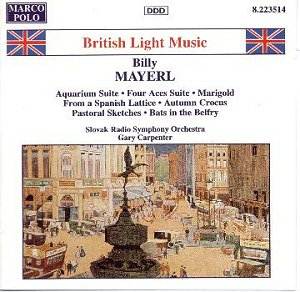
[I suggest that this CD review is read in conjunction with the review of Marigold, the new book on the life and music of Billy Mayerl, included on this site this month.]
This album comprises 21sunny, scintillating numbers many of which will spin around in your head for days. Many were originally written as piano solos. Some have been orchestrated by the composer (which I will asterisk) but most by other arrangers/orchestrators: Fred Adlington, Ray Noble, Hubert Bath, Herman Finck, George Windeatt, Arthur Wood and Alan Nichols.
The concert opens with the work that is always associated with Billy Mayerl, the well-loved Marigold.* But the album also contains a number of other pieces that one immediately recognises even if their names might not be easily recalled, such as the jolly upbeat Bats in the Belfry, and the cheeky Fireside Fusiliers that recaptures the dizzy world of the 1920s flappers.
Marigold (1927) is the earliest piece on the CD. There are three late works from 1956: the charming Minuet by Candlelight*, the equally delightful Waltz for a Lonely Heart* and the ebullient Busybody*, a nice rounded character study of someone who is nosy and boisterous but romantically inclined too (or maybe it's a she?)
The Ace of Clubs Suite (1933) commences with 'Ace of Clubs' that has an appropriate devil-may-care, man-about-town suavity while 'Ace of Diamonds' has a sophisticated, syncopated sparkle. The well known 'Ace of Hearts' has a very appealing tune but the Slovak players seem a little uncomfortable with this one; it sounds just a bit too world weary and it just cannot compare with Billy Mayerl's own piano solo version. The 'Ace of Spades' begins with a magical Ravelian flourish (Mayerl loved Debussy and Ravel) before the tempo picks up and we have syncopations with an oriental flavour - another easily recognisable piece.
The Aquarium Suite (1937) has another well-known number, 'Fantail' - Gershwin influenced, this beautiful fish certainly is very self-aware and rather disdainful with it! Other inhabitants of Billy's aquarium are: 'Willow Moss' a nice slow engagingly romantic jazz-based piece which occasionally ripples and darts about; a decorative 'Moorish Idol' and 'Whirligig'* that's in a real jazzy whirl.
Pastoral Sketches (1928) is a three movement suite that is unusually quiet and restrained in its first movement 'A Legend', and although 'Lover's Lane' seems serenely leafy there is also hints of lovers' quarrels as well as their passion; while 'A Village Festival' contrasts carnival jollity with quieter reflective material.
A Lilly Pond is quiet and whimsical with something of an 18th century elegance about it. From A Spanish Lattice is Spain observed form a distance with much more of Mayerl. Autumn Crocus sweetly lilts and is that Eric Coates peering over the hedge? Parade of the Sandwich Men is full of cheeky Cockney frolics, with the implicit cries of barrow boys.
Although the Slovak players seem occasionally uncomfortable, this is a very commendable and enjoyable album
Reviewer
Ian Lace

JOSE VIANNA DA MOTTA (1868-1948) Symphony in A major À PÁTRIA (To the Fatherland) (1895)
RDP Symphony Orchestra/Silva Pereira
rec 28-30 June 1, 4-6 July 1977, Lisbon ADD PORTUGALSOM STRAUSS SP 4117 [49:03]
Hungarian State Orchestra/Mátyás Antal
rec 21-24 April 1988, Lisbon DDD PORTUGALSOM STRAUSS CD 870016/PS [40:55]
TWO PORTUGUESE RECORDINGS
Vianna da Motta was born in Sao Tomé, one of Portugal's African colonies. A composer of prodigious talent he studied at the Lisbon Conservatory from 1875 to 1881 - an incredibly early age. In 1882 he went to Berlin studying at the Scharwenka Institute. Three years later he went to Weimar where he continued his studies with Liszt and two years later spent time with Von Bulow at Frankfurt. After a sojourn in Geneva he was appointed director of the Lisbon Conservatory a position he held for many years.
His name will be known, if at all, as one of that select Round Table of Liszt pupils. His career as a virtuoso continued undimmed until the last decade of his life. True to his instrument and his talent he wrote the Piano Concerto in A major, a Fantasia Dramática and the Balada Op. 16 all of which will feature on the twenty fourth volume of Hyperion's Romantic Piano Concerto series (CDA67163). Again I hope to review this issue.
In the present review two discs produced by PORTUGALSOM - STRAUSS record two performances of Vianna da Motta's 1895 symphony, premiered in Oporto in 1897. This is, accordingly, a head-to-head review reflecting something of a privileged situation: two recordings of the same symphony and both recordings from the same company. Both have been supported by the Secretaria de Estado da Cultura - a great credit to Portugal and its support of native composers.
What can we expect from the Symphony? It is a longish work - over forty minutes. There are four movements the first and last of which are late-romantic statements in which the influences of Liszt and Tchaikovsky (and a few others) hum and resound. Either could stand freely as a tone poem. The big second movement is a tender hyper-Dvorákian love-song of (for its time) sensuous poetry - think perhaps of Franck's Psyché. The third movement (a sort of rhapsodic scherzo) uses two catchy popular songs from Viseu and Figueira da Foz. It is quite prophetic of Iberian musical accents familiar from Chabrier's España (dating from 1883) and many much later works. The movements are each a reflection of a different poem by Camões. The work is perhaps of lower middle ranking perhaps in the same bracket as Parry's First Symphony (rather a loveable piece) and Stanford's Seventh Symphony (both available on Chandos though the Parry is best heard on a Nimbus disc).
The two performances are quite different. Take the timings:-
Pereira Antal
I 10.14 9.18
II 16.44 13.27
III 6.33 5.59
IV 15.23 11.51The first movement is an allegro eroico but I detected little heroism about it; rather a vainglorious confidence touched with the same wand as Wagner's Meistersinger Prelude and the more portentous moments in Tchaikovsky's Symphony No. 5. Antal's Hungarian orchestra (fascinating to find out why Hungarian and Roumanian orchestras and recording venues were used so extensively by Portugalsom) is richer in the string department than the RDP orchestra. Antal is also more at home with the goad and spur and this celerity certainly pays off in most of the movements, losing ground only in the poetic second which can more than carry Pereira's reflective and indulgently romantic approach. That second movement (Psyché, yes - but also Sibelius Rakastava and Dvorák 's Ninth) is very string dominated and the harp's role is prominent (emphasised in the Pereira recording). The high solo violin passage at the end of the movement reminds us of the Bruch Violin Concerto. A most successful piece in its own right. The third movement is explicitly nationalistic, bright, snappy and wheezing with rustic character - a parallel with the Alfvén Swedish Rhapsodies and Armas Järnefelt's orchestral sketches but with a hint of Glazunov (The Seasons - Autumn). Antal is to be preferred here as he is also in the finale. The finale's bluff and bluster is intermittently engaging and suggests Tchaikovsky's Manfred. To bring the work full circle there are reappearances by themes from the first movement.
The Antal is to be preferred. He keeps things moving along at a nice clip. The poetry is not lost on him. His orchestra sounds better and assuredly so in the case of the strings. The recording quality is all digital and superior to the ADD Pereira from eleven years before.
The sound quality on the Pereira is respectable but not as good as the Antal. The strings have a stridency and aggression noticeable even after some fine-tuning with the tone controls. I note that composer, Joly Braga Santos was the Musical Assistant for the Pereira recording. Pereira, of course, presided over the recording of Braga Santos's extremely fine Fourth Symphony - also available on PORTUGALSOM.
The notes in both Portuguese and English (typo-ridden, I am afraid) are respectable and speak in accessible language for the general listener.
To confuse things a little the covers of the two discs are similar with a polarised photo of a clipper (a reminder of Portugal's great maritime traditions) for the Pereira and an unprocessed photograph of a clipper on the Antal.
Go for the Antal.
Reviewer
Rob Barnett
ANTAL:

PEREIRA:

PS: I have been listening recently to many other discs in PORTUGALSOM's catalogue and will be reviewing before very much longer the four symphonies of late-romantic Luis de Freitas Branco and various orchestra works by Stravinskian neo-classicist Fernando Lopes-Graca.
The prices are: UK pounds 6 and US dollars 10 (freight not included).
The transport costs are :
For UK----- 1 or 2 CDs ------UK £1.60; 3 CDs ----£2.50
For USA---- 1 or 2 CDs-----US$3.50 ; 3 CDs --- $5.50Orders can come by fax to
fax number 351 1 7141723,
by e-mail to: strauss@mail.telepac.pt
or by mail to:
Strauss,SA
Rua Adelaide Cabete, 3C,
1500-023 LISBOA
Portugal.Credit cards are accepted with the name of the buyer, credit card number, validity date and type of card.
orch score and parts available from
Pisao de Mùsica
Secretaria de Estado da Cultura
Av. da Republica 16, 5o
1094 LISBOA Codex
Portugal
MUSSORGSKY: Pictures at an Exhibition. TCHAIKOVSKY: Symphony No. 6, 'Pathetique'. Philharmonia Orchestra Carlo Maria Guilini.
Recorded live in Usher Hall Edinburgh 1961 BBC Legends BBCL 4023-2 [76m] ADD
Save around 22% with
the retailers listed alongside
.
Giulini's masterly way with Ravel's superbly glowing orchestration of Mussorgsky's harrowing musical imagery has always been second to none. This white-hot version compares favorably with the famous mid-seventies LAPO recording for DG and if the latter is more polished and brilliant this Usher hall relay from 1961 is full of dare-devil playing and really has the Philharmonia at its corporate hair-raising best. Giulini favours consistently fast tempos thus adding to the excitement of 'Gnomus' and the chattering 'Tuileries'. The sense of mystery and desolation that permeates 'Catacombs' and 'Cum mortuis in lingua mortua' is another Giulini hallmark whilst the expansive bombast and earth shattering climax of the 'Great Gate of Kiev' is rather magical, although here I marginally prefer the ponderous thread of the DG version. Still this 1961 recording is an enticing prospect and is a fine window on the early conducting of then, a much underrated artist.
The Pathetique' is also superbly crafted, climaxes are studied and emotionally constrained and there are no shows of overt sentimentality. The clear mono sound has much in common with Mravinsky's superb 1955 DG performance that still remains my first choice for this wonderful symphony. However I marveled at the potent force of the Philharmonia's playing in the savage Allegro molto vivace and the sense of desolation achieved in that dismally bleak Finale is also deeply felt by both conductor and orchestra. If not the best 'Pathetique' around, this version will surely win new converts and deserves to be in the catalogue at last. Superb remastering and excellent notes sum up this most desirable reisuue.
Reviewer
Gerald Fenech
Performance:
Sound:

NEXT >>>
 |
Search the Crotchet database from here |
| Discs
on these pages are offered for sale. There is also a page of search
engines from a selection of on-line retailers
here.
Please support this web-site by buying your discs here. Disclaimer: Every effort is made to make sales links to the correct disc but, in the end, you must take responsibility for checking that what you are purchasing is what you want. Some of these discs were not actually available for sale at the time of posting but a link has been made in anticipation of their forthcoming availablility. Any opinions expressed in reviews or articles on this site are those of the author and do not necessarily represent the views of the site owner, Len Mullenger or the Editors. Reviewers and authors retain copyright in their work unless it has been paid for or commissioned by the site owner. All prices, special offers etc relate to the month of publication only or as stated. |
Return to Index of Classical Reviews